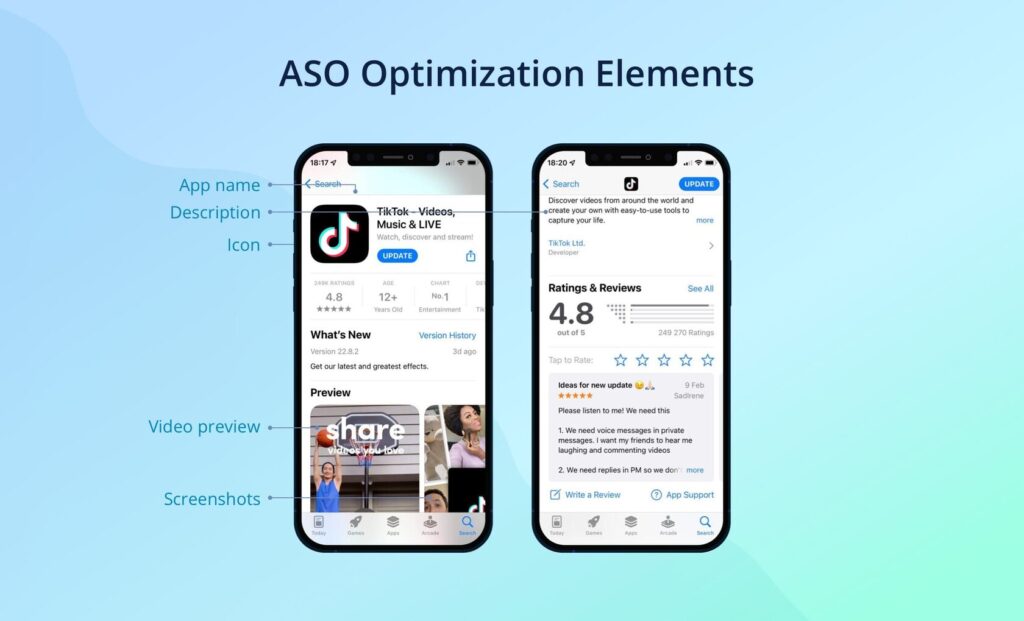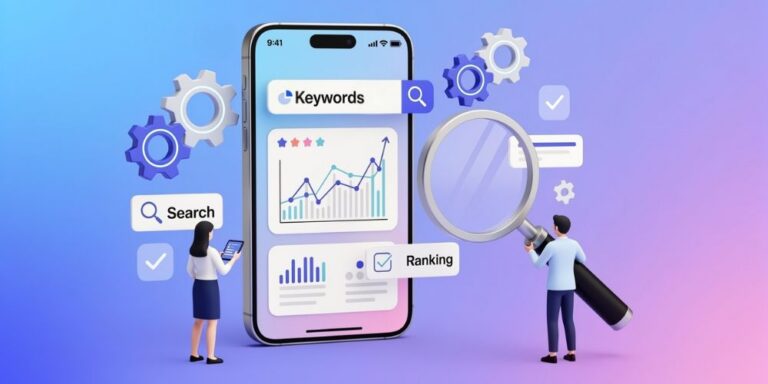Mobile app creation is not an easy business, but it’s only half the battle. Now you need to properly market your product so that it reaches the maximum number of potential users. With a multimillion-app assortment on Google Play and the App Store, it’s not easy to do. That’s why understanding how to market your app before launch is crucial for success.
It is where App Store Optimization best practices come in handy. They mean not only direct marketing steps to increase your app’s visibility but also complex preliminary work. A competent app pre-launch marketing plan includes, first of all, a comprehensive market analysis. With its help, you’ll better understand the target group’s needs, be able to assess the competitive environment, and develop the best strategy for promotion.
Before launching your product, you should carefully read the guidelines of the stores where you plan to host the app to make the launch as smooth as possible. At first glance, it might seem that the Apple Store and Google Play are practically the same. However, they use different algorithms and tools to evaluate and rank products. That is why you need to know all the details to get the most out of each platform.
Table of Contents
How To Market Your App Before Launch: Strategy Steps
In terms of product marketing, SEO and ASO go hand in hand. While the former helps you raise brand awareness and “stir” customers’ interest in a product launch, the latter makes the app visible to users and digital store algorithms. So, your app pre-launch strategy should include steps in both directions.
By using SEO tools, you can expand your reach and increase your online presence. The more people know about your product, the better. Therefore, you should:
- start your own website or blog (or at least get a landing page);
- arrange several collaborations with influencers;
- actively engage users through social networks;
- talk about the app on popular platforms like Reddit and Quora;
- prepare a creative and informative press kit, and more.
All this is an integral part of the global strategy aimed at “heating up” the target audience. Though the media coverage extension does not end after the mobile app launch announcement, it should receive a new round of development. After all the described SEO preparation, you should move on to the final and, perhaps, one of the most critical preliminary stages — App Store Optimization.
Market Research to Know Your Competitors Better
Competitor analysis should be at the top of your app launch checklist. Knowing your rivals and their specifics is critical to ASO, as these are the developers and publishers you’ll be competing against for your target group’s attention. You should highlight those products with which you are in the same category, have the same potential users, and can rank for the same ASO keywords.
Competitor app page analysis should also be a part of your app keyword research so that you can find the most characteristic words, as well as those terms and phrases that will help you become unique.
Track your competitor’s app history
Analyzing and tracking the change in app histories is vital for app pre-launch marketing. By studying previous builds, you can see exactly what the developers have changed, how they reacted to new trends, and which results this led to.
That is, you get the app development dynamics and can use effective tactics for your own strategy. It also helps you discover the weaknesses of your competitors so that you can figure out how to outperform them.
Versions
While launching a mobile app, you probably keep in mind the points you can improve with the next build. So, when analyzing competitors, you should find out how often they update their products and which changes they make.
Remember that Google Play allows you to change the app page listing at any time, while the App Store lets you do it only with the release of a new version. Therefore, if you develop a product for iOS or iPadOS, you also need to keep track of the changes the publishers have made to the text or graphic elements of their pages.
Metadata
The term “metadata” refers to various parts of your app page. Analyzing the competitors’ metadata during the pre-launch marketing phase will help you evaluate your capabilities against rivals, learn how they present their products and talk about key features, identify the most winning listing options, and much more. When working with the App Store data, it’s important to keep an eye on the best players to understand what helped them reach the top.
Rating & rankings
Analysis of ranks and ratings helps you keep track of the demand for competitors’ products in a particular region. You can see at which point it falls and rises. Together with the previous items, it gives you the opportunity to determine which actions of the developers or marketers and changes in their ASO could lead to such jumps and falls.
App Store Keyword Research
Keywords are your assistants in dealing with the app stores’ algorithms. When building a pre-launch app marketing strategy, you should carefully analyze the most commonly used terms and phrases.
Understand how potential users might look for your product, which words your direct competitors use, and how you can stand out from a bunch of similar titles.
When optimizing text assets, you should use both high- and low-volume words to keep up with the competition. Read more about working with keywords in our comprehensive article “How to Optimize ASO Keywords.”
Define Your ASO Strategy
Part of understanding how to market your app before launch a successful app lies in identifying key KPIs that will help you measure success. Since ASO is primarily about boosting the product’s visibility in app stores, the essential metrics are:
- keywords or category rankings;
- conversion rate;
- userbase growth (MAU and DAU);
- ratings and reviews;
- users’ Lifetime Value, and so on.
You should determine in advance which indicators you will focus on and which results will be considered acceptable. You should monitor the product performance after launch using app download analytics and other statistics.
This way, you can timely identify weaknesses that slow down the growth of important indicators and work on them. Constant tracking of KPIs is necessary for detecting new problems and their solutions.
Main ASO Optimization Elements
From an ASO point of view, different app page elements affect ranking algorithms in different ways, as well as the formation of the visitors’ first impression. When preparing an app launch campaign, it’s vital to take into account each app store’s peculiarities, as well as the guidelines and requirements of all platforms where you plan to publish. Otherwise, you risk not passing the moderators’ check and wasting time refining your page.

App icon
It’s the first element that catches the eye of users. Moreover, it appears literally anywhere in app stores where your product can be mentioned (various selections, collections, editor’s choice lists, etc.). People tend to form their opinions based on visual data, so special attention should be paid to icon creation.
The design needs to be concise, attractive, and reflect the app’s essence. To learn more about creating the all-important graphic asset, as well as other elements, read our post “Tips for App Icon, Screenshots, and Videos.”
App title
It’s the second most crucial element of your page, which, like the icon, appears everywhere. It carries the most weight in terms of ranking algorithms, so in addition to your product name, it should include the most relevant keyword.
This way, you will not only increase searchability but also be able to build a brand. Both app stores allocate only 30 characters for it, so they need to be used wisely. Be sure to check out your competitors’ and big developers’ options to get insights and cool ideas. Avoid content that can mislead users or is false.
App description
This element functions differently in Google Play and the Apple Store, although both set a 4000-character limit. The first uses the text in the description to rank apps, so you need to insert the right keywords when writing it. At the same time, you should not write too much about your product since not all visitors read the full description. The main idea needs to fit into the first couple of sentences shown at the top.
Unlike Google Play, the App Store does not rank apps based on description texts. There is a separate field for keywords here, and the description is only needed so that you can write about your product. It gives iOS developers some leeway. However, they should also not write too large text; they need to be able to attract the visitors’ attention from the first lines. It’s essential for understanding how to market a new app.
Screenshots & videos
The page graphic elements contribute to the faster info perception and, accordingly, the formation of the first impression. While both stores provide plenty of screenshot slots, it’s best to use just a few to highlight your app’s key/unique features.
Moreover, not all pictures are shown on the app page. With the help of a preview video, you can also tell more about your product, demonstrating the features of working with it.
Localization
Localization is necessary if you plan to enter the international market. As a rule, for the first launch, it’s enough to have one locale for the main region. When you decide to expand your audience, you should collect keywords and analyze the audience and competitors in the new country.
The markets of different countries can significantly vary, and to successfully launch and get a high rating, you need to take into account all the language and cultural features.
Make Your App Pre-Launch Strategy Work to Its Fullest
Careful preparation for publishing an app on Google Play and App Store is the foundation of your future success. Now you know what place ASO takes in this process and how important it is. Let’s summarize all of the above to solidify the material. Here are the steps how to market your app before launch:
- Warm up your audience with SEO tools, influencer collaborations, and press kits.
- Study your competitors: their app histories, versions, ratings, and metadata.
- Make complete keyword research and get a list of words of different types (low-, mid-, and high-frequency).
- Pick and set KPIs to help you measure your work’s effectiveness.
- Optimize the main app page listings and assets: your icon, title, description, screenshots, videos, and localization.
Do all of the above with our tips in mind, choose the best day to launch an app (statistically, it’s Wednesday evening or Thursday), and publish your product on the selected platform. If you thought that now you could finally relax, you were wrong. The path to success is not easy; it requires constant performance monitoring and regular revision of the strategy to implement the most relevant mechanisms in it.




